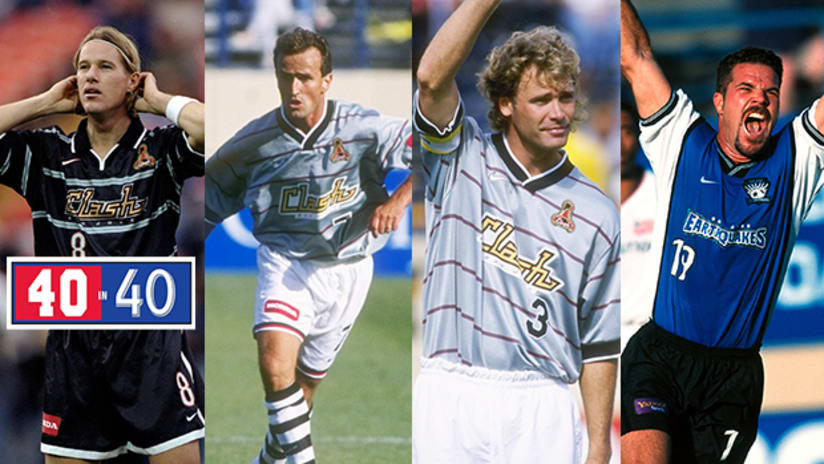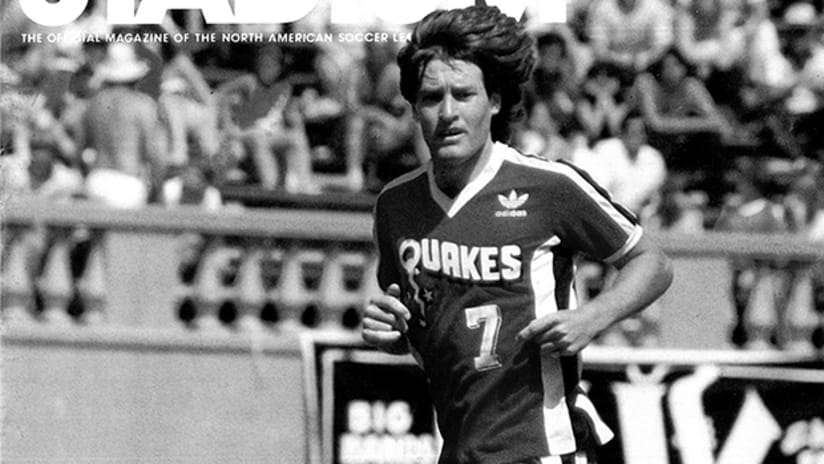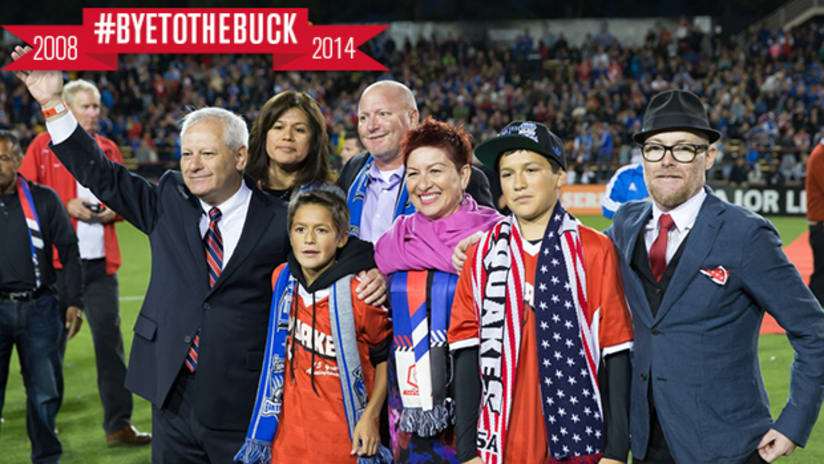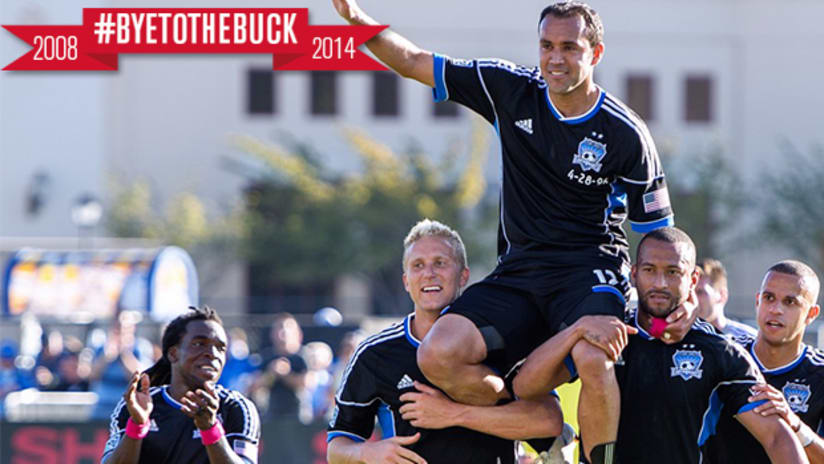As a tribute to our 40th anniversary, we're proud to unveil the San Jose Earthquakes' 40 in 40: 40 weeks of 40 stories from 40 years of Earthquakes soccer. From March until December, fans can follow along and learn about key moments of our history - and see how our past, present and future ultimately shape our new identity.
-----------------------------------
When looking back at the 40 year history of the San Jose Earthquakes, it is easy to overlook the years between the NASL and MLS clubs. The patchwork soccer leagues that sprung up around the country in the wake of the NASL’s folding had acronyms that seem better suited to a bowl of alphabet soup than professional sports. And though it would be more than a decade until the start of MLS, soccer survived, and sometimes even thrived, in the interim.
A high-water mark for Bay Area soccer in those years was formation of the San Francisco Bay Blackhawks in 1989. Featuring a mix of U.S. national team players and local talent, the Blackhawks went on a successful four year run that saw the team win one national championship, finish runners-up another season, and play in the prestigious CONCACAF Champions Cup. The roster, a who’s who of soccer greats, would feature many players that would make an impact in MLS, especially in San Jose.
Current Earthquakes’ general manager John Doyle played for that team as did fellow club Hall of Famer Troy Dayak. San Jose’s 2005 Supporters’ Shield winning head coach Dominic Kinnear was a prominent member of the squad along with national team legends Eric Wynalda and Marcelo Balboa. Local standouts goalkeeper Mark Dougherty and forward Jeff Baicher proudly wore the black and yellow of the Blackhawks during those pre-MLS years. Head coach Laurie Calloway later took on the same role with the Clash.
“The final product of that Blackhawks team would have been a good MLS team,” remembered Doyle. “If you could have kept all those players on the San Jose team in 1996, it would have been a really good team, rivaling DC United at the time. But all the players got dispersed to other teams. We had so many of the national team players from the west coast on that team. It would have been great to have that roster together for the start of MLS.”
The Blackhawks’ founding owner, Dan Van Voorhis, was committed to assembling a stellar squad of local talent, including 17-year old prodigy defender Dayak, the youngest ever signing by the league, on the team’s first roster.
“I was fresh out of high school and going to college,” recalled Dayak. “To have a professional organization believe in you so strongly that they are willing to set up a fund for you to come out of college and play professional soccer was amazing. I was very honored to be in that unique situation.”
“It was a different time,” said Doyle. “We played all over the Bay Area with the Blackhawks, including many games at Spartan Stadium. I have lots of memories of all the stadiums, but Spartan was my favorite.”
In that inaugural 1989 season, first-team WSL All-Stars Doyle and Kinnear were instrumental in leading the Blackhawks to the second best record in the league playing on the same field that they watched their NASL-era heroes play a decade before.
“Looking back, it was special to play with that team,” shared Kinnear. “I came from a soccer family, and way back in the day, we watched the Earthquakes of Johnny Moore and George Best and Mike Hewitt at Spartan Stadium. I remember my first game on the Earthquakes field. It was an awesome realization.”
From those halcyon days of youth, when all that really mattered was the game itself, the future movers and shakers of Earthquakes soccer in the MLS era kept their focus on the field, never really thinking to a day when professional soccer would be as established in the Bay Area as it is today. Doyle and Kinnear, as did many of their teammates, juggled time between their club and the national team during their Blackhawks tenure, happy to have a place to play and fans to support them.
“We were so young at the time, and all we were trying to do was play professional soccer and make a little money,” said Kinnear. “Quite a few of us did go on to play in MLS, but that was definitely not our focus at the time.”
“You hoped that something like that was coming, but we never really thought too much about it,” added Doyle. “It’s incredible to me looking back at it that we did get a league and that it has survived and thrived for going on 19 years now.”
“As players, we loved having a place to play,” said Dayak, “and weren’t always conscious of the fact that it would lead to bigger and better things.”
“The Blackhawks were a special team,” remembered Dayak. “We went to the national championship game in 1990 and lost on penalty kicks. I vowed to myself that I would never lose a national championship again as a player, and you know what, the next year we won it. And after that, I won four more national titles. It was great period for me to develop from.”
The 1991 Blackhawks were the first championship team that Dayak played on, and the talented teen was a major force behind its success. Doyle, following the 1990 World Cup, left for Swedish club Orgryte IS, but Kinnear was still an integral part of the team. Still stocked with local and national team talent, the team achieved a second place finish in the regular season and won the title against the Albany Capitals.
“We brought in some strong characters that made us a national contender,” said Dayak. “It was something special that they put together. I firmly believe that some of those players if still in their prime would compete in Major League Soccer today.”
Indeed, the Blackhawks were the most powerful team in the country, and counted among their players more than a dozen that would go on to feature in MLS. But that league was still half a decade from its realization, and the Blackhawks went about their role as the preeminent club team in the U.S. by entering the 1992 CONCACAF Champions Cup.
The Blackhawks navigated a difficult group stage that including two-game series with opponents in the North and Central American region. A penultimate series victory against Honduran champions Real C.D. Espana, with the home leg played at legendary Kezar Stadium in San Francisco, saw the Blackhawks through to the group stage finale against Mexican powerhouse Club America and their star forward Hugo Sanchez.
“We beat a team from Belize, then Honduras, and went on to play Club America,” said Kinnear. “They were a great team at the time and we lost the first leg at the Azteca in Mexico City 3-1. We came back to Spartan Stadium and beat them 2-1 in the return leg, which wasn’t enough and we lost by a goal, but it showed what a strong team we had.”
It was a performance that was remarkable at the time and one that even MLS teams today would be proud of. Unfortunately for the Blackhawks, it also marked the beginning of the end for the club, as a year later it had withdrawn from the APSL.
A bright shining light on the U.S. soccer landscape, the Blackhawks remain an important link in the 40 year history of professional soccer in San Jose. The 1994 FIFA World Cup, which featured six matches at Stanford Stadium bridged the years between the Blackhawks and the Clash, keeping local attention firmly on the sport in those intervening years.
Wynalda, a hero of that World Cup, joined the Clash in 1996 and suited up with Doyle and Dayak. A year later, Kinnear returned to the Bay Area and reunited with his old Blackhawks teammates. Baicher and Paul Bravo featured on that 1996 side as well providing even more ties to the Blackhawks. And Calloway completed the reunion as he reprised his role roaming the sidelines at Spartan Stadium.
“The APSL brought something special to our area,” recalled Dayak. “It gave us a place to play. It gave fans hope for the future of professional soccer, a foundation. It was an incubation period that allowed us to grow ties in the community, where some great players got their starts. We had the chance to hone our craft, and if we didn’t have that team, the Blackhawks, we probably wouldn’t have ultimately had an MLS team in San Jose.”
Dayak was a hard-nosed defender for the Clash, and after returning to the club following a lengthy recovery from a neck injury, a two-time MLS Cup champion with the Earthquakes. Along with Doyle, Dayak is a member of the Earthquakes Hall of Fame, and he continues his role in the game as a renowned youth coach.
“We established the soccer culture in San Jose for years to come and that is still growing today,” explained Dayak. “Coming out of that time, you still have former players making contributions in MLS and in youth soccer, still coaching and developing players and helping soccer grow in the United States. We had fans from all over the Bay Area that would come out to watch us, from Sacramento to Spartan Stadium, and those connections went a long way to strengthening a soccer tradition in the area.”
Kinnear, upon retiring from MLS and getting into coaching, returned to San Jose as newly installed head coach Frank Yallop’s assistant ahead of the 2001 season. When Yallop left to take the reigns of the Canadian national team, Kinnear stepped in as the Earthquakes head coach, cementing his place as a founding father of San Jose soccer. And he tapped his best friend Doyle to be his assistant coach.
“My first season as the head coach in San Jose,” said Kinnear, “knowing that you are leading the team you followed as a kid, and to see your best friend next to you as your assistant and one of your players was your teammate on one of your first professional teams, it was definitely fun.
“It’s kind of weird when you look back at it to go from fan, to player, to coach,” continued Kinnear. “And along the way you get to do it with a lot of people you grew up with is definitely special.”
Doyle, more than any other figure, embodies what it means to be an Earthquake. From his days as a fan in the stands, to his time as a youth player with the fading NASL Quakes, to his current role as the longest tenured general manager the organization has ever known, Doyle’s connection to San Jose soccer spans almost the entire 40 year history of the club.
“I’m extremely proud that I had the opportunity to play for as long as I did,” said Doyle. “To come back when MLS started and play for San Jose for five years was special. It still burns that we didn’t win a championship in those years, but I was happy to go on and contribute as a TV commentator and an assistant coach. And now as the general manager comes a lot of responsibility and pressure to not let your home-town people down. Everyone knows you and you want to do a great job.”
And among the founding fathers, with his trademark black cowboy hat perched upon his head, is Dayak. No player in the history of the organization bleeds the colors of his club quite like Dayak, and the man they call “The Beast” will always wear his loyalties proudly.
“It has always been a club I wanted to be associated with,” said Dayak. “My unwavering support for my club is a responsibility that is more than just being a good player. It has been important to me to be a role model for the club and the community. Being a founding father, we had great people we looked up to as young players and I am happy to return that favor with my association with the organization. It has always been a source of pride.”
Robert Jonas is a writer for CenterLineSoccer.com and SJEarthquakes.com. Send him feedback on Twitter: @RobertJonas




